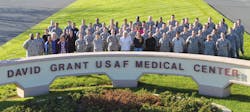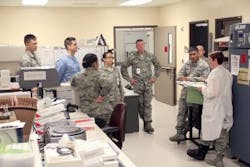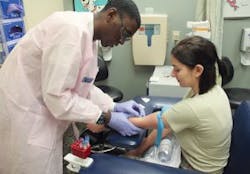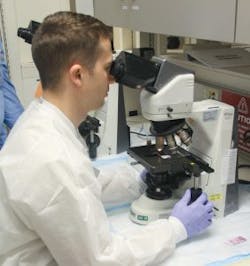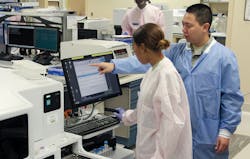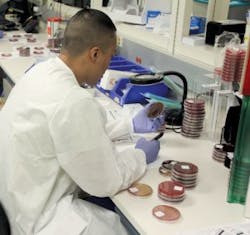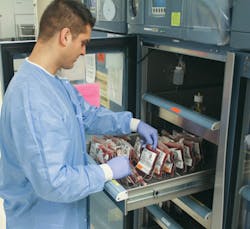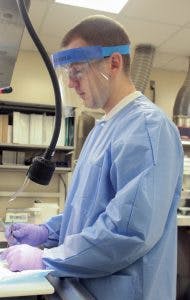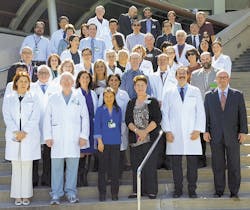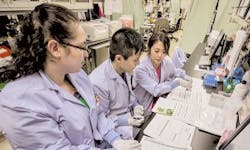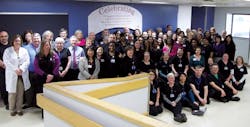Travis Air Force Base, located in the San Francisco Bay area, near the town of Fairfield, California in Solano County, is an integral part of the American military. The host unit at Travis AFB is the 60th Air Mobility Wing, which is the largest wing in the Air Force’s Air Mobility Command. Travis AFB has a fleet of C-5 Galaxies, KC-10 Extenders, and C-17 Globemaster III aircraft. It is home to the 60th Air Mobility Wing, the 349th Air Mobility Wing, and the 621st Contingency Response Wing.
It is also home to the David Grant USAF Medical Center, and the David Grant Medical Center (DGMC) Laboratory, which is the largest clinical laboratory in the Air Force Medical Services (AFMS). The editors of Medical Laboratory Observer are proud to salute the David Grant Medical Center Laboratory as the 2017 Lab of the Year. We congratulate all of the labs who submitted nominations, as we celebrate with our readers Medical Laboratory Professionals Week, April 23 through April 29, 2017.
As the largest clinical laboratory in the AFMS, the DGMC Laboratory, with 91 military and civilian full-time equivalents, provides a full spectrum of testing for 465 healthcare providers, who in turn serve a patient population of 368,000 active duty/reserve/veteran/retiree military, military family member, and Department of Defense (DoD) civilian staff. The DGMC lab supports 325,000 annual patient visits and 6,000 admissions. It is the largest point-of-care testing program in the Air Force, managing 23 sites. David Grant Medical Center is a 116-bed medical treatment facility, and the lab performs 1.2 million tests annually in Chemistry, Special Chemistry, Hematology, Coagulation, Immunology, Microbiology, Point-of-Care Testing, Histology, Cytology, and Transfusion Services.
MLO asked those submitting nominations for the 2017 Lab of the Year award to discuss their lab in terms of these six criteria: Customer Service, Productivity, Teamwork, Education and Training, Strategic Outlook, and Lab Inspections. In the nominating form and in a subsequent interview with lab leaders, the DGMC Lab gave MLO much more information than we have space to present here, but, to organize this article, we will use those categories as sub-sections to review some highlights.
Customer Service
In discussing service provided to both internal and external customers, DGMC lab leaders stress the importance of access and communication. They have facilitated better patient care by implementing the MiCare secure messaging service, which allows patients to access health information online. Patients can choose to receive notifications when their lab results are reported, view and print lab results, and look up pending tests from their MiCare online profile. MiCare can be accessed from phone, tablet, or computer. The patient community, including veterans, is being encouraged to use this valuable service.
Healthcare providers are also able to access test results via four IT platforms: CHCS, ALTA, CoPath and Essentris. Outside providers that order lab tests for patients receive results via secure fax line, enhancing continuity of care from the DGMC to their organizations.
During 2016, the DGMC Lab initiated an auto-validation process improvement. This process, used in many of the core laboratory testing platforms including chemistry, hematology, and coagulation, has reduced “lab to provider” result times by more than 30 percent. The lab also has an extensive, proactive outreach program that joins with all hospital departments that use lab services to ensure that it has the appropriate test menu, that physicians are using resources responsibly, and that an interactive format is in place to address safety-related or operational incidents.
Productivity
The military as a whole focuses on productivity in utilizing resources effectively to meet mission needs, and the DGMC Lab fosters and reflects that focus in a variety of measurable ways.
In 2016, the lab formed a 10-person team tasked with creating an upgrade plan for eight core laboratory analyzers and initiated new contracts worth $8 million. This 400-hour undertaking enabled the lab to obtain (from Siemens) a fully automated robotic testing line, which is projected to recoup five FTEs/$1,500,000. Leveraging this new technology will allow the lab to run more tests, more efficiently, with less staff.
At the same time, process improvements related to how the lab manages cardiac panels led to expedited processing, outdoing the national turnaround time average by 41 percent. In addition, process improvements to tuberculosis management procedures led to a reduction from 72 to 24 hours, reducing costs and decreasing isolation times for patients. The histology department improved its tissue staining procedures, reducing staining time by half. The lab also revamped its records management procedures last year, allowing it to recoup 33 percent of storage space while still upholding HIPAA requirements.
In Microbiology, the launch of a new analyzer cut processing time from 15 minutes to five, and increased accuracy by 20 percent. The implementation of five new rapid tests, including Shiga Toxin, Stat Campylobacter, and Bacterial Motility, cut manual testing time by 25 percent and led to a five percent reduction in errors. By creating and implementing a new cross-training generalist program, the Micro lab saved two FTEs via efficient human resources allocation. It also began a new construction redesign project that improved workflow by 11 percent. In Transfusion Services, an effective new blood utilization project reduced waste of blood products by more than 50 percent.
Teamwork
DGMC holds trainings for staff members on how to work together to provide cost-effective, efficient care in the safest manner possible. Individual lab departments hold “safety huddles” daily, followed by a comprehensive, hospital-level safety huddle to which the lab contributes its input. Lab leaders stress that these daily interactive meetings are valuable vehicles for sharing lessons learned, innovative ideas, and patient and staff safety concerns. Says Lt. Col. Patrick Kennedy, Clinical Laboratory & Pathology Flight Commander, “These meetings allow us to come together as a unit and create a synergy that helps our staff to be more efficient, patient-centered, and productive.”
The lab also teams with other organizations in various capacities. It partners with the Department of Veterans Affairs, which has a clinic in the hospital, to perform lab testing for veterans. It teams with the Air Force and Armed Services Blood Program to ensure the safety, purity, and potency of blood products and to provide input for planning for next-generation IT and blood processes and procedures. The lab also partners with the hospital’s Clinical Investigation Facility, providing manpower and lab work to support research efforts, and joins with the Armed Services Whole Blood Processing Laboratory (West) to support its mission to provide blood products for military treatment facilities throughout the Pacific region.
DGMC pathologists also provide medical director oversight for seven other military medical facilities, traveling around the country to ensure that uniform standards are observed. The Anatomic Pathology department is a West Coast hub for DoD consultations, receiving samples from 39 other DoD and 10 VA/civilian facilities. These include DoD hospitals in Japan and the Republic of South Korea.
Internally, lab personnel are key members of hospital disaster management teams. Regular training is held at the hospital or in other designated areas to simulate a natural or human-made disaster. Those drills continuously improve coordination between the lab and other departments, as well as between the hospital, the military base, and civilian authorities, responders and healthcare facilities.
In addition, in 2016 more than 30 lab staff and students collaborated with base and community agencies to volunteer 387 hours for 12 community service projects. Examples of staff volunteer work include the Boy Scouts, Habitat for Humanity, Airmen Against Drunk Driving, Foster a Dream, the USO, and youth sports. In the military culture, volunteer activities are closely tied to team-building.
Teamwork is also promoted by professional development courses offered to the staff. The lab facilitated three Four Lenses Personality Test classes to foster communication and understanding. A total of 46 personnel completed the six-hour class.
The Air Force brings together men and women from various backgrounds and cultures and instills in them common ideals and a common purpose. Furthermore, in the lab, there is a significant turnover. “Turnover is a special challenge that our military laboratory faces,” says Lt. Col. Jimmey Labit, Laboratory Services Chief. “Because our military members transfer from base to base every two to three years, we can experience anywhere from a 33 percent to a 50 percent turnover annually. A focus on leadership and a strong training program are key to meeting this challenge.”
“One special quality about our laboratory as a military organization is our focus on leadership,” adds Maj. Edward Griffin, Central Operations and POCT Chief. “Managers organize; leaders inspire. We do not focus only on the organizational aspect of our mission. We also seek to provide leadership by example—to inspire our staff to be the best they can through teamwork and inner dedication to the cause of protecting our country.”
Education and Training
In that context, the lab has a thorough and standardized new employee orientation and training program, including an overview of DGMC’s healthcare service and support mission and operating structure. It has an extensive and standardized competency program and process, and it focuses on exceeding training standards as set forth by CAP, The Joint Commission, and AABB. Of special note is the implementation of a computerized CAP competency program. Courses are built for each lab task/procedure and include such items as checklists that can be referenced by staff, educational materials, and a post-course exam. The program tracks initial, six-month, and annual assessments and automatically assigns and notifies staff members when they are due for their next assessment.
As part of the strategy to train and incorporate junior laboratorians, the DGMC lab has implemented an “All Hands on Deck” program, daily from 10 AM to 2 PM. During that time, senior leadership and technical supervisors are on the bench working side-by-side with airmen (junior techs) to ensure that they receive the mentorship required to master necessary skills. Mentors engage the junior staff in critical thinking exercises to promote ownership of duty and ensure focus on patient welfare.
In addition, military staff members receive extra training on the military aspects of their work with a special focus on skills and competencies needed for missions and agencies that they may deploy to such areas as Iraq, Afghanistan, Qatar, Jordan, Kuwait, and other areas to support the nation’s strategic goals. Staff members provide laboratory services, blood support, and other general military services as needed. These additional levels of training and responsibility are not found in the civilian world and are a unique aspect of the DGMC lab’s utilization, education, and training programs.
With regard to education and career advancement, the lab also has a dual military and laboratory professional support system. Base facilities include an educational center and several local and national college representatives to assist staff members and their families. Military staff can receive tuition assistance to help pay for college costs, and the Air Force has a program to reimburse staff members who pay for and pass professional laboratory certifications. Military staff members also receive the Post 9/11 GI Bill, which pays for up to three years of full-time college tuition.
All staff members have access to free online CMEs at the lab’s expense to assist them in staying current in their field and with their professional certification renewals. Military staff members new to the field are given free career development courses on every aspect of laboratory testing and procedures spanning, on average, one year’s worth of coursework. Military staff are also offered free College Level Examination Programs on base, and the lab also has instituted a volunteer study program to assist medical laboratory students in passing their ASCP MLT exams.
The lab has also led with a comprehensive Individualized Quality Control Plan (IQCP) Program that meets the requirements for an alternate quality control option as allowed by 42CFR493.1250. Implementing its IQCP program, which includes 12 IQCPs, has allowed the lab to customize its quality control plan based on its testing use and methodology, personnel competency, and clinical environment.
At the 2016 Clinical Laboratory Management Association/Society of American Federal Medical Laboratory Scientists (CLMA/SAFMLS) annual meeting, the staff presented on management and team building, and the DCMG lab was selected to make four presentations at the 2017 meeting.
Strategic Outlook
The DGMC lab‘s strategic outlook includes its mission, its vision, and its strategic plan:
- Laboratory Mission: “To optimize patient care 24/7 through accurate, timely, laboratory support and state-of-the-art technology, and to train tomorrow’s leaders in the science of laboratory medicine.”
- Laboratory Vision: “To lead the way in laboratory innovation, readiness, service, and training.”
- Strategic Plan: The lab’s plan focuses on three areas:
- “Improving efficiencies through better training innovation, standardization, and communication by utilizing the right personnel while optimizing the resources to complete the job.”
- “Developing staff members through professional development and empowerment.”
- “Leaning forward to better serve patients by increasing customer focus areas both internally and externally, and maintaining an effective continuous quality improvement program [while] implementing as many ‘best lab practices’ as possible.”
“What binds us together in the Air Force is our Core Values: Integrity First, Service Before Self, and Excellence In All We Do,” says Lt. Col. Kennedy. “We have a very diverse staff from different backgrounds. Our Core Values are our guiding principles that enable us to work as a team to provide quality healthcare service support.”
Lab Inspections
DGMC is The Joint Commission-accredited, and the laboratory has a record of outstanding regulatory inspection results. The lab is CAP-accredited. Its Transfusion Service is also consistently successful in FDA and AABB regulatory inspections. In addition, the laboratory has the largest and most robust Air Force NAACLS accredited medical laboratory technician clinical training program in the United States.
The Quality Assurance Team includes staff members from all departments. Team members have diverse backgrounds and many decades of laboratory experience and include specialty-focused members such as Certified Quality Auditor (ASQ), Specialist in Blood Banking (ASCP), MBA in Finance, MA in Organizational Leadership, MS in Business, California licensed Clinical Laboratory Scientists, and many others. Several members are also active CAP inspectors and AABB assessors. Members ensure that the lab is current with CAP, AABB, TJC, FDA, Department of Defense Clinical Laboratory Improvement Program (the military form of CLIA), and ISO standards and requirements.
The laboratory has a strong quality program. Members of the Quality Assurance Team perform audits and process improvement initiatives on a continual basis. In the area of management responsibility, managers provide a vision, are customer-centered and committed, and keep staff members informed. In resource management, the focus of the lab is having the right person do the right job while creating and maintaining a positive work environment. In its quality management system, the lab ensures proper oversight and documentation of processes to ensure quality work in meeting patient needs. In the area of product realization, the lab ensures that final testing results and blood products issued are top quality, meet regulatory requirements, and are delivered to patients and healthcare providers in a timely and proper manner.
“Our laboratory’s continuous quality improvement committee has facilitated improved processes and attained excellent reviews from accreditation agencies,” says Laboratory QA Manager Maria Langeslay, MT (ASCP), CLS. “This committee tracks more than 35 quality monitors including all areas of the lab and POCT to evaluate trends in all process components (preanalytical, analytical and post-analytical). As part of our High Reliability Organization initiative, which is David Grant Medical Center’s goal, we use any findings as an opportunity to learn and improve lab practices and processes to provide better care and ensure patient safety.”
Celebrating Lab Week
And, the DGMC Lab has big plans for Lab Week, both in terms of acknowledging its internal customers and reaching out to its external customers, the public. The Wing Commander will formally declare Lab Week, and then the celebration will begin. Among scheduled activities are a 5K run and multiple games; a blood drive; sponsored meals; an Open House so that community members, including patients, can see how the lab operates—how the profession of clinical laboratory medicine unites with the profession of arms to create excellence. In addition, a series of articles about different sections in the lab will appear in the base publication, as a build-up to what will surely be a memorable Lab Week for the David Grant Medical Center Laboratory.
The editors of MLO wish all of our readers the very same!
First runner-up:
Cedars-Sinai Medical Center
Cedars-Sinai Medical Center (CSMC) is a full service academic medical center lab which serves the needs of inpatients as well as outpatient clinics in addition to its outreach to clients throughout Southern California.
The department of Pathology and Laboratory Medicine has more than 80 MDs and PhDs and more than 500 employees. In 2016, the lab received more than 287,000 outreach laboratory requisitions and performed more than five million tests.
Improving the patient’s experience has been a major initiative over the past year. CSMC lab leaders have identified the following four “Vital Behaviors:” 1) Treat patients, family members, and co-workers with courtesy and respect. 2) Explain things in a way that patients, family members, and co-workers will understand. 3) Listen carefully in order to understand patients, family members and co-workers. 4) Anticipate and respond to patient, family member, and co-worker requests and concerns in a timely manner.
In partnership with the Antimicrobial Stewardship committee at Cedars-Sinai, the Microbiology division collaborated with Pharmacy to expand rapid diagnostic testing (RDT) to support timely decision making for a patient with bacteremia, with the goal of optimizing antimicrobial therapy. This has resulted in a 10 percent decrease in Antibiotic Days of Therapy house-wide. An even more significant decrease (32 percent) was also seen in days of therapy using anti-pseudomonal antibiotics without substitution.
In 2015, the Molecular Pathology division was selected as the sole Roche Ampliprep testing site for Bio-Rad’s Value Assignment Program. Molecular pathology establishes the reference range for Bio-Rad QC materials manufactured for HBV, HIV, and HCV quantitative viral load tests.
In 2016 Cedars-Sinai was selected by the U.S. Department of Health and Human Services to serve as a regional treatment center. Cedars-Sinai and the California Department of Public Health will share the grant from the federal agency through fiscal year 2019 to strengthen the delivery of specialized emergency medical care. The federal grant is part of the $339.5 million in emergency funding appropriated by Congress in 2014 to ensure that the nation’s healthcare system is prepared to treat future patients with Ebola or other highly infectious pathogens. Their national network will serve patients from California, Arizona, Nevada, Hawaii, and United States territories in the Pacific.
Also last year, the CSMC Microbiology division expanded the use of existing molecular platforms using syndromic pathogen identification panels to diagnose sepsis, respiratory, HSV, diarrheal and parasitic infections. Organism identifications that use to take two to three days via culture are now available the same day.
The lab also saw significant advancements in 2016 with regard to turnaround time more generally:
- CSMC added a new STAT PTH assay to their Roche Cobas e411 in the Cancer Center has reduced TAT by 60 percent.
- Fluid Cell Count (FCT) specimens from the Emergency Department (ED) are now sent to the Core Laboratory instead of the ED, resulting in 80 percent of testing completed within a 60-minute goal (vs. 26 percent, previously).
- The lab implemented a workflow analysis for its Kidney Transplant Services, which reduced lab TAT by 15 percent. It also worked with laboratory support services to ensure that is was getting samples in a timely manner, which reduced TAT by 50 percent.
CSMC has also been successful with adding an automated coagulation testing process, improving a process that frequently had issues where the specimen was not delivered either in a timely manner or at all. The programming of the automated line was modified such that when testing at the first location was complete, all coagulation specimens would be put back on the line and aliquoted for the secondary location if there was additional testing. In this manner, the process was automated and no specimens are missed for secondary tests.
Second runner-up:
UKHC Enterprise Laboratories
Headquartered in Lexington, KY, University of Kentucky Healthcare Enterprise Laboratories (UKHC) performs laboratory services to clinical and anatomic labs at UK Chandler and UK Good Samaritan Hospitals.
UKHC has grown dramatically in recent years. Between 2004 and 2015, hospital discharges increased 88 percent while the complexity of the cases they treated moved them from the 25th percentile of academic medical centers to the 75th. At the same time, overall improvements in the quality of care and patient safety led to UK HealthCare receiving the UHC Rising Star Award in 2013 and becoming a national leader in patient safety in 2015. It has received Magnet status, the highest recognition available in the nursing field.
The UKHC lab bills approximately 3.4 million tests per year. Its disciplines include Core Chemistry, Microbiology, Special Chemistry, Blood Bank, Immunomolecular Pathology, Genomics, Cytogenetics, Cytology, Surgical Pathology, Histology, Immunohistochemistry, Cell therapy and Autopsy.
Both patient and employee safety are of utmost importance for UKHC. As one example of the lab’s dedication to safety and comfort of both internal and external customers, lab leaders recently identified noise pollution caused by nitrogen generators in Toxicology and are installing a centralized nitrogen generation system to supply nitrogen to the four LCMSMSs in the lab and reduce the noise level.
Also, several technologists and leaders have created a focused customer service training module for the Central Processing and Core lab staff to ensure that a consistent and positive message is being delivered to customers.
In addition to investing in and upgrading the lab’s state-of-the-art technology during the past few years, lab leaders also undertook a department “face-lift” both to raise morale and increase output, while a reshuffled floor plan allows for easier maintenance of processors and recycling management. Revised policies and procedures have been implemented, nearly eliminating redundancy, which ultimately reduces errors that could jeopardize patient care.
Implementing teamwork within other departments, such as collaborating with nursing to enhance education, has also been part of UKHC’s strategy. The lab staff recognizes that without teamwork within the lab and between the lab and other departments of the hospitals, it would not be able to sustain high quality in light of the organization’s growth over the last several years. Input from all staff is part of continuing improvement, as the best ideas often come from the staff performing the work.
In submitting their nomination form to MLO, UKHC representatives noted, “A critical component of employee engagement is personal acknowledgement.” Education and training are stressed as opportunities for employees to advance their care. Three career development tiers have been established to provide recognition of a high level of performance: bronze, silver, and gold. Advancement is predicated on achieving a set of performance standards and personal development initiatives and does not carry over from year to year.
In 2016 UKHC took on the conversion of staff titles from MT to MLS; a big undertaking, but the lab had reached a point where it was necessary to separate the staff titles in the esoteric labs from the traditional Medical Technology disciplines. The lab now has Laboratory Scientists, certified and uncertified, and MLS, certified.
In line with replacing and embracing new and emerging technologies to provide more accurate, timely results, the lab has acquired a high end LC/MS/MS to develop in-house testing (LDTs). It also continuously evaluates and improves point-of-care testing (POCT) practices at ambulatory clinics. Other strategies include investing in Microbiology automation (Wasp and WaspLab) and Core Lab (Roche automation and Sysmex), and the lab has pioneered interfacing with Copan Italy and Beckman Coulter to develop the Sunquest interface for WaspLab. Lab leaders are currently working with Luminex to validate/develop the Sunquest interface for the Verigene system.
UKHC is accredited by CAP, AABB, FDA, TJC, FACT (Foundation for the Accreditation of Cellular Therapy), and OIG (Office of Inspector General). Many UKHC staffers are seasoned inspectors for CAP, AABB, and the Forensic Urine Drug Testing CAP program. The lab also has recently acquired a Quality Manager at Chandler Hospital and a Quality Coordinator at Good Samaritan, which allows lab leaders to keep abreast of changes in regulatory management and manage quality, compliance, and safety on a daily basis. UKHC’s lab inspections have been consistently successful.
